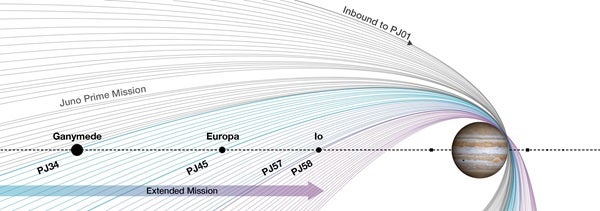NASA’s Juno spacecraft just made the closest flyby of Jupiter’s moon, Europa, in over two decades. Juno swept within 219 miles (352 kilometers) of the icy world on Thursday, Sept. 29. The pass was only a mile shy of the closest visit on record, set by NASA’s Galileo mission in 2000.
One look at the image above and you can get a sense of how close Juno got to the jovian moon. The craft’s JunoCam zoomed in on Annwn Regio, a fractured region near Europa’s equator. And thanks to the contrast between the day and nightside, terrain features are also brought into view. Bright and dark ridges and troughs crisscross the surface like scars. Near the terminator, the boundary between light and dark, lies a strange pit that might be a degraded impact crater.
Hidden beneath this worn and gnarled surface may be a haven for life, as Europa is one of the worlds in our solar system that scientists think could harbor liquid water. Europa’s water would be locked in a subsurface ocean buried miles beneath its icy surface, but researchers think it still could host the conditions necessary to support life.
While Juno’s recent flyby of Europa was short — just two hours — its observations will be used to support future missions to the intriguing moon, including NASA’s Europa Clipper. Currently scheduled to launch in 2024, Europa Clipper will be stationed around Europa in order to perform repeated flybys and investigate whether this world really harbors an ocean capable of sustaining life.
But until Europa Clipper launches, the data collected during Juno’s flyby will have to sustain researchers. And thankfully, it has promise.
“It’s very early in the process, but by all indications Juno’s flyby of Europa was a great success,” said Scott Bolton, Juno principal investigator from Southwest Research Institute in San Antonio, in a press release. “This first picture is just a glimpse of the remarkable new science to come …”
That science includes some of the highest-resolution images of Europa taken to date, as well as information on Europa’s shell structure, interior, surface composition, and ionosphere. Juno also collected data on how the moon interacts with Jupiter’s powerful magnetosphere.
The flyby also set Juno up for a shorter orbit around Jupiter, taking it from 43 to 38 days. And for those eager to see even more of the Galilean moons, Juno will visit Io — the most volcanic body in the solar system — in 2023 and 2024.











